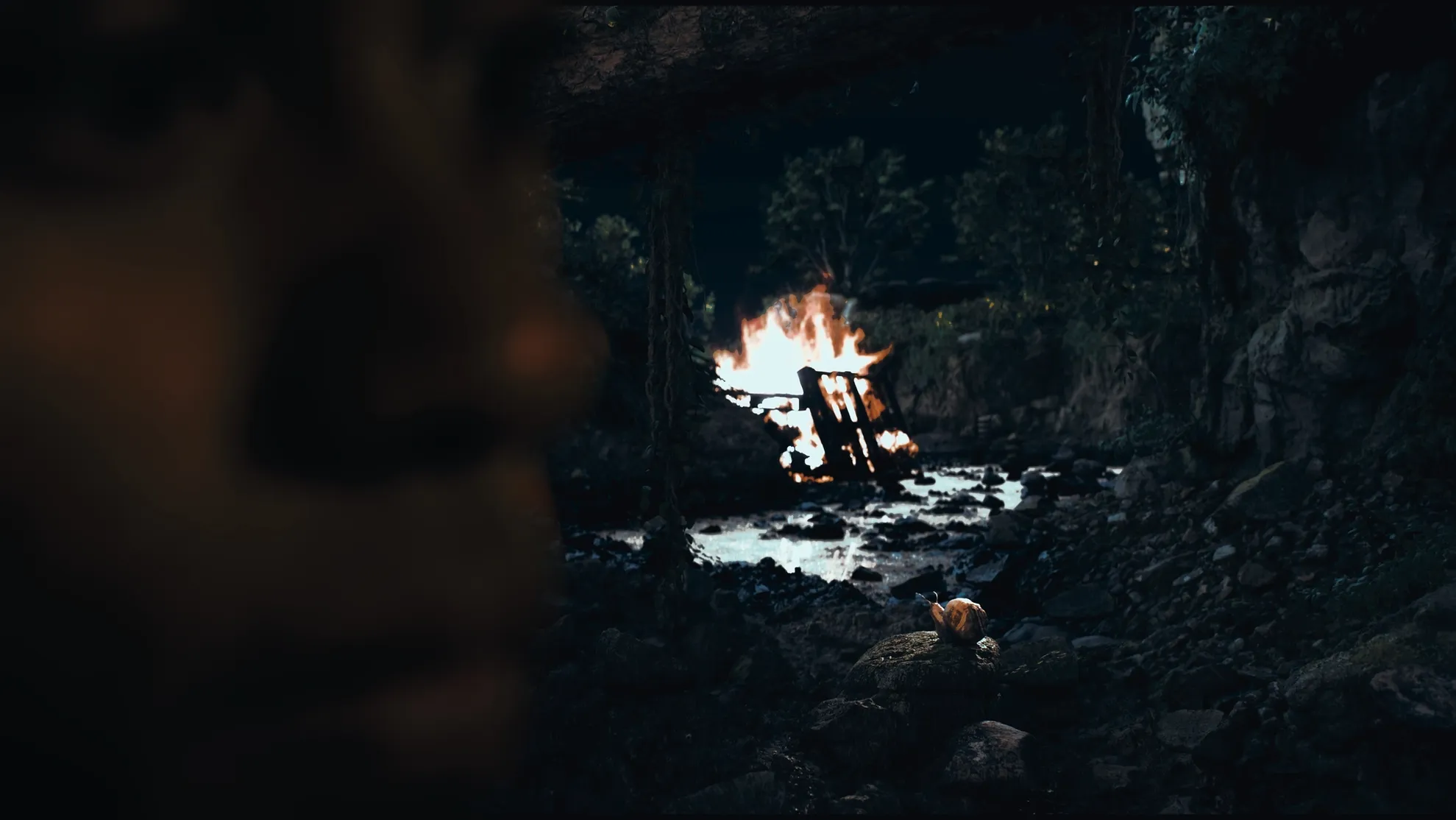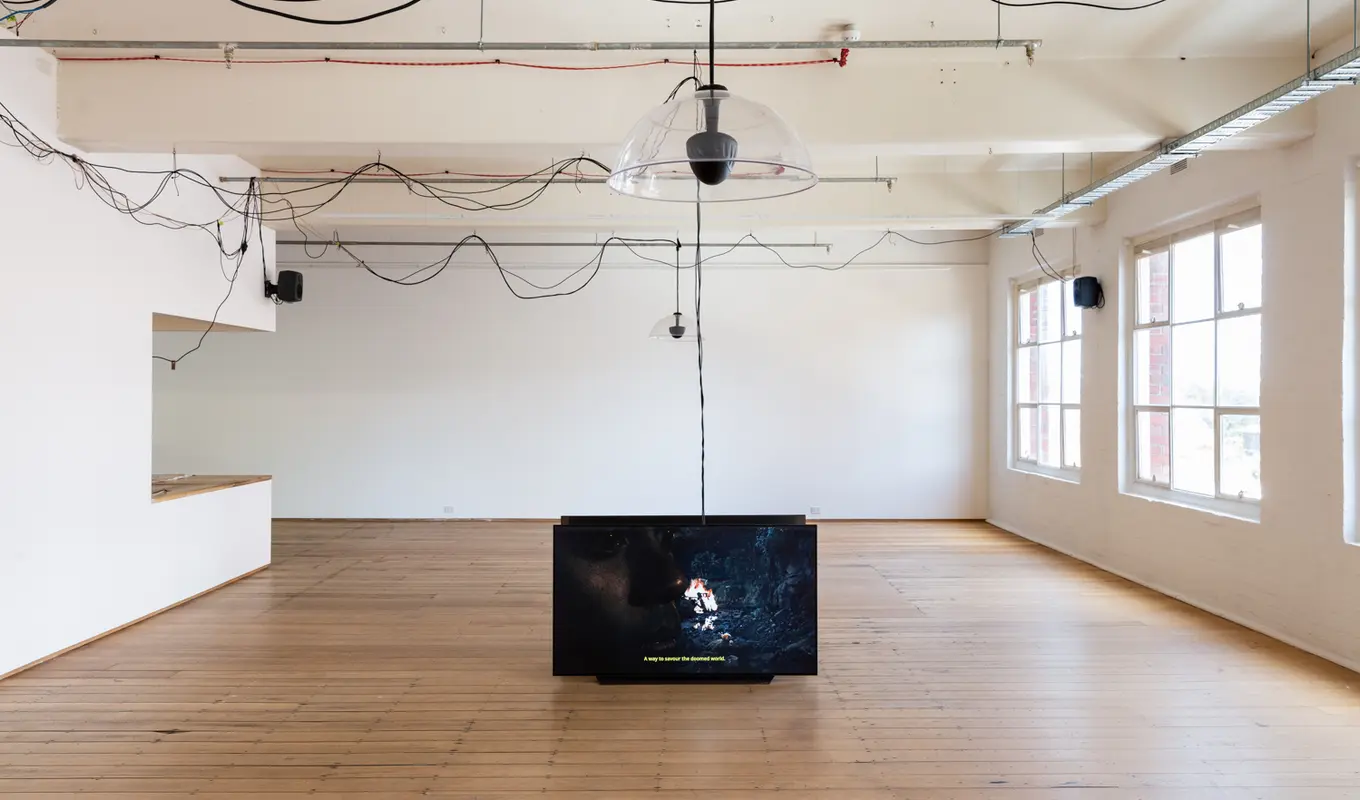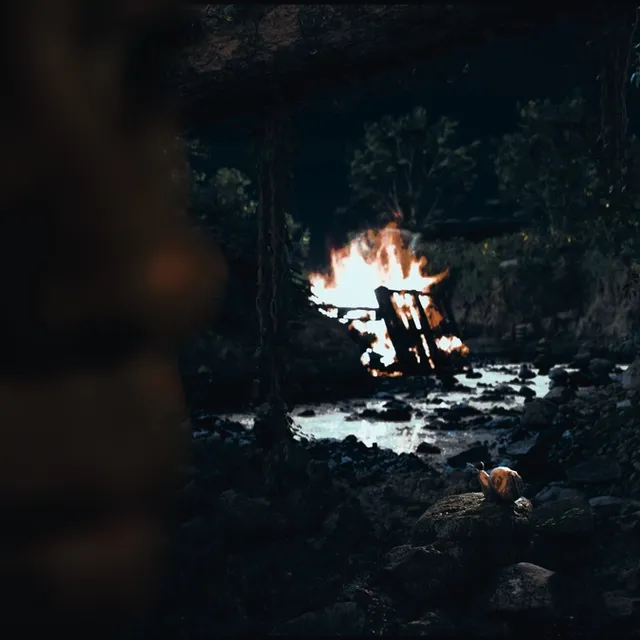Melissa Ratliff
“Tongue becomes hand becomes world: Akil Ahamat’s storytelling in the dark ”
A reader of Akil Ahamat’s practice will notice their works’ textual, intertextual and hypertextual quality, also evident in the Extinguishing Hope and its collectible shrinkies (more on it to follow).1 Ahamat’s frequently text-based video and audio installations, as well as game-based experiences, are in ongoing conversation. Moreover, their world-building includes as its mortar various references that – to a reader of contemporary theory and literature – allow them to be cruised as an annotated bibliography.2
Take their early work Muscular Dreams (2016), whose narration references the 1996 live-action and animated movie Space Jam, and whose title comes from decolonial writer Frantz Fanon’s 1961 The Wretched of the Earth.3 The video’s closing line (‘Even with my foot pressed against your throat, I hope the spaces between us can stay soft’) became the title of Ahamat’s So the spaces between us can stay soft (2018), tethering the two. Among the references for the latter work is 2018’s Gore Capitalism, a book that lent words to one of the script’s melancholy expressives: ‘I don’t expect you to really see me through this iridescent mist’.4 In the book, author Sayak Valencia studies violence’s role in the development of capitalism and hyperconsumerism in the context of Mexico – the mist referring metaphorically to a veil through which violence is viewed in mediated contemporary culture. Through Ahamat’s word harvests and intertextual approach, we parse key themes for the artist who, among other recurring motifs, has engaged with consumerism and coloniality as systems that condition contemporary subjectivity.
Such themes are barrelled in Ahamat’s work-worlds with the scroll and deep-dive of online experience, where infotainment meets identity formation in a junky crystal palace of opinions, memes, thirst traps, mediatised war, and other terrors and pleasures. Two aspects of this tech-mediated quasi-social space in particular headline Ahamat’s practice: the state of concentration in the post-internet age, and the phenomenon of ASMR YouTube videos.5 Pragmatically, Ahamat’s ‘slow cinema for short attention spans’6 is accessible in ways that video art (in gallery spaces) tends not to be. The works’ one-to-two-minute run times and looping structures are suited to our ‘extreme present’ – the term that Shumon Basar, Douglas Coupland and Hans Ulrich Obrist use in their analysis of a world defined by the internet.7 Just as appropriate for the intense now is ASMR, the affective motor behind Ahamat’s desire to create intimacy in gallery spaces, which is very often achieved through the artist’s near-whispered monologues and dialogues.8 These two aspects power the (non-linguistic) feelingscape of Ahamat’s works.

While the affective force of Ahamat’s practice is its most discussed attribute, its writtenness and seriality clearly carry large swathes of its meaning. Not only via interlinked text fragments and ideas, but through distinct motifs, such as the figure of the snail that has appeared and reappeared in the artist’s work since 2019. Extinguishing Hope marks its sixth year as the artist’s maybe alter-ego: an avatar, carbon-based kin, night dweller, hero of defensive adaptations. The shelled mollusc first entered the scene as a silt grey, 3D-printed resin plaque titled Be tormented by me, babe (2019), depicting a snail in low-relief. Its epigraph – the work’s title applied in gold eye shadow – is a line from the title track of Canadian pop singer Carly Rae Jepsen’s album E•MO•TION (2015). This marked the enigmatic wall sculpture as more than garden humour; it glided (as so many of Ahamat’s works) into the sticky territory of relationships. That it did so interspecially set up a stage where human emotion could become feelingly invested in more-than-human realities. It’s silly, but it also strums an ecological and planetary chord that can be sensed in many of Ahamat’s works.9
After the diminutive sculpture came the more animated Falling to Forever (2020), a third-person POV game played as a snail.10 Players manoeuvre around a rock pool and catch bubbles in a digital landscape bathed in inky, phosphorescent light. It’s meditative – a therapeutic immersion appropriate to that peak year of distanced relations under COVID-19 restrictions (while again striking a non-anthropocentric chord).
A sparse, audio-based installation titled Unchained Melody (2020) was the stage for the snail’s next outing, in a work Ahamat developed as a finalist in the NSW Visual Arts Emerging Fellowship at Sydney’s Artspace. For this work, Ahamat trialled a new architecture for public intimacy in the form of a curved, stand-up glass ‘sonic shower’. In a time of water scarcity – the work’s conceptual premise – soothing ASMR effects stand in for the comfort of taking a shower. Here, the snail is the author of voicemails that play through a parabolic speaker overhead, describing an increasingly distanced relationship. Snails (at least the terrestrial kind) ‘only come out when it’s raining,’ says one message. In a water-limited environment, a snail would suffer existential stress, given that its gliding movement relies on mucus secretions that depend on adequate moisture supply.
In a significant turn, the video Dawn of a day too dark to call tomorrow (2021) brought Ahamat and the snail together for the first time. This precursor to Extinguishing Hope was created for Sydney Review of Books’ experimental online essay series. The human and mollusc duo comprise the entire world of the work, shown in a static shot closely cropped to Ahamat’s live-action face and torso and the snail’s realistic 3D-modelled body in the foreground. Both face the camera/audience in a sign of their estrangement (if also a theatre convention).11 If it has been tempting to think of the shelled protagonist as a stand-in for the artist, their on-screen relationship complicates the theory. Their hushed tones (Ahamat) and subtitled ASMR crinkles (snail) as they converse are frequencies befitting the nighttime scene’s private intimacy and moonlit stillness. Their exchange has Ahamat’s usual rhetorical and poetic register, while formally relying on a structuring device that sees both characters plausibly say the same thing in a seemingly infinite loop, with subtle shifts. Ahamat initiates the conversation – ‘How can I get your attention without pleading to some kind of urgency?’ – a minute or so later responding to the very same question posed by the snail. As the loop’s temporality becomes apparent, so does the emotional impact of the dialogue’s interminable exchangeability – the frisson of a relationship of closeness on the precipice of a break.

Reading Dawn of a day and Extinguishing Hope together, two further conceptual and visual motifs become clear, though admittedly they’ve been present from early on. So obvious in the narrative mode of Muscular Dreams and embedded in all Ahamat’s condensed scripts, storytelling is an explicit theme in these latest companion works. ‘None of the stories you tell ever go anywhere, everything compressed into a shimmering unison,’ observe Ahamat and the snail alternately in the cycling script of the 2021 work. ‘The stories you tell yourself delivered you into this present,’ one continues, ‘And I guess the ones we tell each other deliver us into the future,’ is the response. Stories, we learn, beyond their information and entertainment value, are performative – accounts that ‘do’ something in their telling.12 In Extinguishing Hope, their importance is elaborated upon via their difference to promises, where – as the conversation reveals – stories always mean something, while promises may not.
Put differently, stories’ doing-power makes them spells – incantations spoken or scribed as ‘tongue-becomes-hand-becomes-world’, to quote an evocative construction from the 2019 book Omnicide by Iranian-American philosopher and literary theorist Jason Bahbak Mohaghegh.13 A study of manias and the ‘will to annihilation’ via the work of Middle Eastern poets and fiction writers, Omnicide is one of several texts that Ahamat – a self-described ‘reader into oblivion’ – read during the development of Extinguishing Hope.14

Another text accompanying Ahamat through this work’s realisation is the Javanese kidung (‘song’ or ‘incantatory poem’) called Kidung Rumeksa Ing Wengi (in English, Song guarding in the night). Important in Javanese literary culture, it is attributed to the fifteenth-century Muslim ‘saint’ Sunan Kalijaga, and its words invoked for protection against the dangers and evils active in the hours between dusk and dawn.15 Evidence that stories both ‘mean’ and ‘do’, the version of the kidung that Ahamat came across in 2022 was an early-nineteenth-century copy of the text, written by a Javanese person who had been exiled to Sri Lanka by Dutch colonists – the same displacement experienced by some of Ahamat’s own ancestors. The poignancy of the discovery for Ahamat, in addition to its biographical relevance to the Sri Lankan Malay artist, was its relation to a question they had been dealing with: ‘How do we find our way in the dark’?16

Darkness is the second key conceptual and visual (as well as textual) motif in Dawn of a day and Extinguishing Hope. And, as I look back on the trajectory of Ahamat’s practice as discussed in this text, I notice its passage from blue to dusk to night – a diurnal to nocturnal progression that charts the artist’s growing engagement with ‘the contemporary dark age stemming from information saturation and misinformation’.17 On first reading this characterisation, I wondered about Ahamat’s use of a nomenclature of darkness. While the appellation ‘Dark Ages’ for a period in early medieval Europe is taken to refer to a cultural decline after the ‘light’ of classical antiquity, the designation actually comes from a complaint by fourteenth-century Italian poet Petrarch about the quality of the literature of his time.18 This is interesting to consider in relation to the progression from orally transmitted stories to print (sixteenth century) and now digital media, whose ephemerality – not bound to the container of the book – is ‘something more akin to the folkloric oral culture of the middle ages’.19 If what circulates in contemporary digital networks has attained a folksy, populist and negative valence (misinformation, far-right ideologies), it is darkness invoked as a synonym for secrecy, evil, ignorance, error. Darkness, however, is frequently also depression, despair, bleakness; this befits our time of permacrisis.

While the cinematically spare use of light in these two most recent video works is partly an acknowledgement of the disorienting confusion of our much-discussed ‘post-truth’ reality – with its signals of rising fascism – it would be disingenuous to overlook nighttime’s other offerings: celebration, communion, rest. And, snails remind us: cover and protection. (Snails’ preference for night allows them to avoid both predation and desiccating heat.) Night is also when we might talk fearfully with our partners and friends about love, war or a catastrophically off-kilter planet. Fundamentally, it is catastrophe that blankets Extinguishing Hope.20 Its ‘rave at the end of the world’ ambience, with its wasted landscape, flickering fire and sounds of distant revelry, is evoked by the words that close the looping script: ‘A way to savour the doomed world’.
Ahamat’s darkness is ‘tomorrowlessness’.21 It’s snail time. It’s a slowed down, hibernatory reprieve. I find a further clue in the poem that closes a recent text by Ahamat in the online journal Runway, where the title of their latest work appears:
Take this unbeing as gracious inheritance.
We misinterpret, we misattribute, we forget.
Let that help us extinguish the fire of hope of what once was and walk into the dark.22
Inspired by the kidung’s talismanic promise, yet cautious of the kinds of attachments to the past that are associated with authoritarian turns, Ahamat speaks here of positive negations – not holding on to, not fetishising our inheritance (‘what once was’).23 The words remind me of the late US cultural theorist Lauren Berlant’s book Cruel Optimism (2011), its title referring to a condition where ‘something you desire is actually an obstacle to your flourishing’.24 Despite deteriorating social, economic and environmental conditions, she explains, in the present ‘crisis ordinariness’, people maintain fantasies of the good life – for instance, that hard work can guarantee happiness.25 If this is the kind of hope that can be extinguished in favour of other ways of living, we can walk (un)knowingly into a dark that – as Ahamat’s body of work suggests – can also be therapeutic.

This essay was commissioned by West Space for the Extinguishing Hope printed publication alongside contributions by Archie Barry, Sebastian Henry-Jones and Bahar Sayed.
Melissa Ratliff lives in Sydney on Gadigal/Wangal lands. She is an occasional writer currently working as an editor at the Art Gallery of New South Wales. Prior to this, she was Curator — Research at Monash University Museum of Art in Naarm/Melbourne, where she co-curated Language Is a River, the experimental program VERS: On Pleasures, Embodiment, Kinships, Fugitivity and Re/Organising and edited numerous publications.

